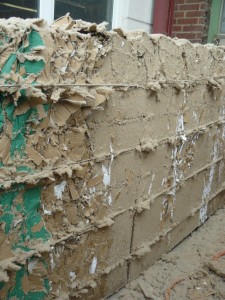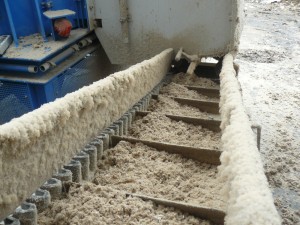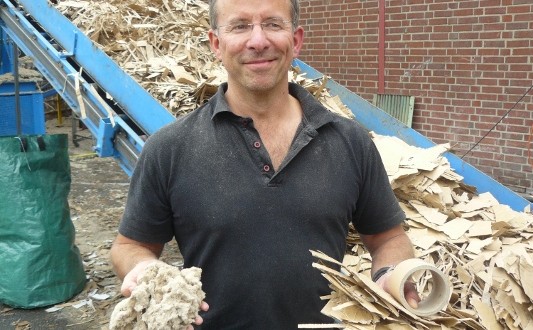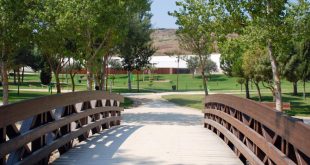ECO123 spoke to the inventor of a completely new method of producing recycled paper, the biologist Dr. Philipp Althöfer (47). He studied natural sciences at the universities of Düsseldorf, Bonn and Cologne. The topic for his diploma thesis was: Biotechnical treatment of process-water using the example of a paper factory processing scrap paper in a large city. And his 2001 doctoral thesis: Softening and re-use of biologically treated circulation water from paper manufacture. Althöfer is a lecturer at the University of Cologne, teaching the course “Biological Cleaning of Wastewater”. Just before this edition went to press, Althöfer showed ECO123 the first machine to use this new process and switched it on.
ECO123: Are you more of a scientist or an entrepreneur?
Althöfer: From the amount of time I spend, I’m definitely more of an entrepreneur. But I have also worked scientifically in the field for a long time. If you can offer some scientific expertise, the obvious thing to do is to form a company. I founded Aerocycle GmbH in Cologne in 2001 and after I completed my doctorate I started working independently.
Why does it say Cologne-London on your website?
That is because of scientific cooperation in the electrotechnical field with Kings College, London. We have been able to build up a good collaboration. The processes are all equipped with electronic controls these days.
How does it come about that someone invents a machine like this?
You come across things that you would like to improve. And if you then get scientifically involved and get more immersed in the subject, you can see the technical problems and would like to be able to offer solutions. Either you are like that, or you’re not, it’s about whether you have a compass for technical connections. Nature is the model: there’s no waste there, only the most efficient organisms and processes survive, that’s why biology helps a lot.
If I understand you correctly, you have invented a machine in which water only plays a subsidiary role in the recycling of paper. How do you manage to bring ecology and economy together?
 You must imagine that you have a bale of scrap paper, which normally weighs 350 kg. It contains all sorts of scrap paper: cardboard, corrugated paper, magazines, newspapers. None of it is sorted and it’s not clean. It’s full of impurities, things that you don’t want: plastics, metals, sand, glass – accounting for up to 20% of the content. This scrap paper bale travels around the whole world: every year, some 200 million tonnes of scrap paper circulate around the globe. That is the key raw material. It is exported as far as China. Almost every paper factory uses scrap paper, some work with nothing else. Scrap paper has to be treated. The fibres are needed for paper manufacture. So, every paper factory has to pulp the scrap paper. For this – and this is the traditional technique – a huge amount of water is used. Usually, the proportion of scrap paper to water is 5% paper and 95% water. That is put in the pulper which every paper factory has. You can imagine it like this. An oversized mixer pulps the bale and breaks the scrap paper up in the water. That uses a lot of energy because all the water is moved around too, and becomes dirty, because at that point all the impurities are still in the water.
You must imagine that you have a bale of scrap paper, which normally weighs 350 kg. It contains all sorts of scrap paper: cardboard, corrugated paper, magazines, newspapers. None of it is sorted and it’s not clean. It’s full of impurities, things that you don’t want: plastics, metals, sand, glass – accounting for up to 20% of the content. This scrap paper bale travels around the whole world: every year, some 200 million tonnes of scrap paper circulate around the globe. That is the key raw material. It is exported as far as China. Almost every paper factory uses scrap paper, some work with nothing else. Scrap paper has to be treated. The fibres are needed for paper manufacture. So, every paper factory has to pulp the scrap paper. For this – and this is the traditional technique – a huge amount of water is used. Usually, the proportion of scrap paper to water is 5% paper and 95% water. That is put in the pulper which every paper factory has. You can imagine it like this. An oversized mixer pulps the bale and breaks the scrap paper up in the water. That uses a lot of energy because all the water is moved around too, and becomes dirty, because at that point all the impurities are still in the water.
In our process, it’s the exact reverse: 95% scrap paper and only 5% water. A bit of water – soft rainwater – is also needed – we work with a beating tool in a mill – and it gets very hot there. The fibres would burn if we didn’t add any water, but this mostly evaporates again. At the same time dust is bound to it. We use much less energy in this process. The dry process has the decisive advantage that the impurities can be sorted much more easily and separated from the paper fibres.
…I imagine that the metals are removed with magnets…
…correct. And the non-magnetic material is separated by gravity. We call this integrated gravimetric separation. While the mill turns, we separate the materials and the heavy bits simply fall to the bottom. That only works when it’s dry, and traditionally several steps are needed for this.
What do you do with plastic?
Plastic is also heavier than paper fibres. It is milled along with the paper and can be separated when dry because it is specifically heavier. An everyday example to illustrate this is, when you smear your jeans with mud, it is much easier if you leave it to dry and then brush it off. You can almost get the marks out completely and only then put the jeans in the washing-machine. If you leave the mud on your jeans and put them straight in the washing-machine, you can’t get the mark out completely. One key advantage of the process is that scrap paper is processed dry.
What possibilities open up if you use less water when producing recycled paper, and so produce less wastewater?
First of all, the huge saving of water itself. Then the avoidance of the resulting wastewater. That is always more expensive that fresh water. In the process, we can not only do the pulping, but also separate out fillers and inks in the dry process. Traditionally, “cleaner” stages were needed and the disadvantage was always the same: in their wet state, the particles are always difficult to separate. They are pressed at high pressure through fine pores. That requires a lot of energy. In their dry state, they can be shaken out of the fibres.
Are there different sizes of machine and how much does this one cost?
This one can produce up to 30,000 tonnes a year. That is 5 tonnes per hour or 100 tonnes per day. That is enough for a very small paper factory. Most produce between 50,000 and 500,000 tonnes of paper a year. We called our process FRT (Fibre Refreshing Technology). The idea behind this is that, with traditional recycling, the quality of the paper normally decreases continuously. And so you always need fresh fibres so that the product retains a certain firmness. With this completely new technique, the fibres are preserved and all the paper products can be produced that are of interest to the paper industry: from envelopes to toilet paper. The smallest machine would cost you about 500,000 euros.
FRT (Fibre Refreshing Technology). The idea behind this is that, with traditional recycling, the quality of the paper normally decreases continuously. And so you always need fresh fibres so that the product retains a certain firmness. With this completely new technique, the fibres are preserved and all the paper products can be produced that are of interest to the paper industry: from envelopes to toilet paper. The smallest machine would cost you about 500,000 euros.
Does your invention also save energy and space?
As much as 80% less electricity. Bales with the same dimensions that are pressed from FRT fibres, weigh 30 – 50% more than traditional scrap paper bales. That means that the capacity of trucks and container ships can be much better used with significant ecological advantages: different forms of transport which, until now, were limited by their maximum load volume before they reached their maximum payload, can carry 30 – 50% more FRT-fibre as compared with traditional scrap paper bales.
Many thanks for the interview.
Entrevista:
Fotografie:
 Eco123 Revista da Economia e Ecologia
Eco123 Revista da Economia e Ecologia




